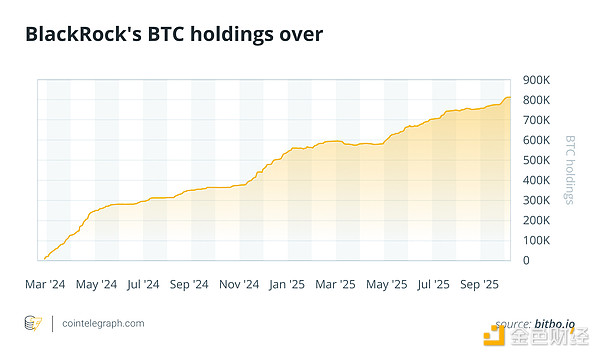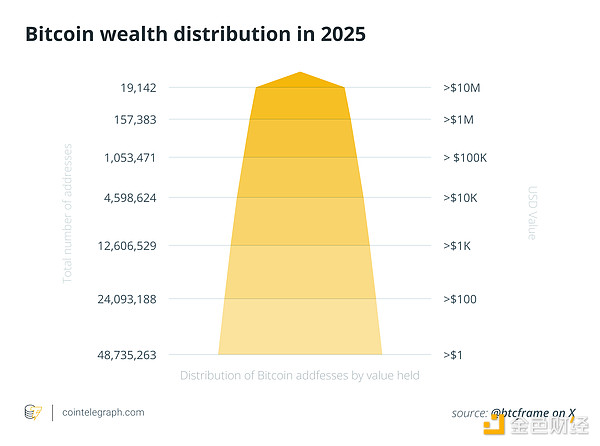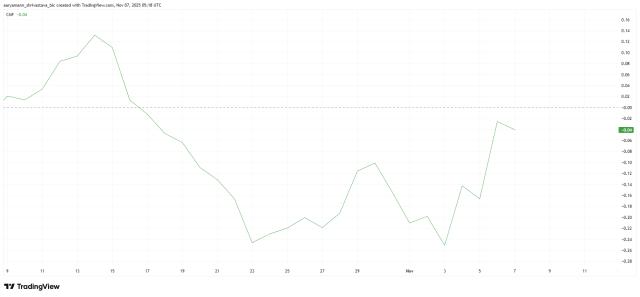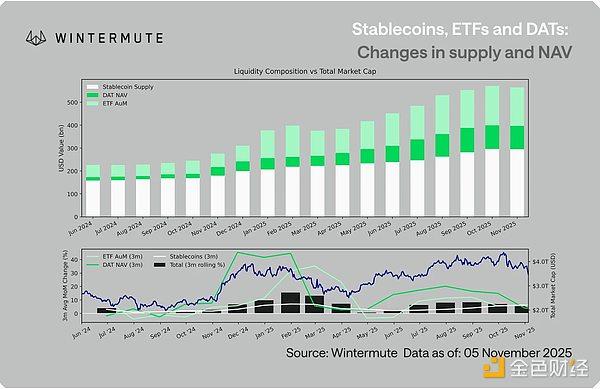Author: Bradley Peak, Source: Cointelegraph, Translated by: Shaw Jinse Finance
Key points
Since 2024, inflows and outflows of funds into spot ETFs have been the main drivers of Bitcoin price fluctuations.
With exchange balances near multi-year lows, any large orders will require a longer trading process to complete.
Large holders often split their trades or use over-the-counter trading platforms to mitigate the impact of significant “wallet transfers.”
Funding rates, open interest, the US dollar, and yields often have a greater influence on market trends than any single wallet address.
Everyone "knows"that whale trade Bitcoin, and they can still shake up prices.
Since the advent of spot exchange-traded funds (ETFs), Bitcoin's price movements have often been driven by the inflows and outflows of these ETFs. It also depends on the actual supply of Bitcoin available for trading on exchanges, rather than the willingness of any single wallet. For example, BlackRock's iShares Bitcoin Trust ETF (IBIT) currently holds over 800,000 Bitcoins on behalf of thousands of investors. The liquidity of this ETF is comparable to that of any single holder.
By taking derivatives contracts into account and the broader risk appetite/risk aversion sentiment, you can see the real situation more clearly.
This article succinctly refutes the various rumors surrounding whale trading, explains the truly important market mechanisms, and provides a quick data checklist so you can understand market trends without chasing every trending news item about "whale just making moves."

What kind of investor qualifies as a "whale"?
In the cryptocurrency world, a "whale" refers to an on-chain entity holding at least 1,000 bitcoins. Many dashboards specifically track bitcoin holders in the range of 1,000 to 5,000 bitcoins.
An entity refers to a group of addresses controlled by the same owner, rather than a single wallet. Analytics firms use heuristics such as common spending and change detection to group addresses to ensure that the same holder is not counted twice in different deposits.
This distinction is crucial because the raw number of addresses on a "rich list" can exaggerate concentration. Large services such as exchanges, ETF custodians, and payment processors operate tens of thousands of wallets, and tag clusters help differentiate these wallets from end-investors. Research from academia and industry has long cautioned against drawing conclusions based solely on address data.
The methodologies differ. Some whale metrics include service entities and companies such as exchanges, ETFs, or custody pools. Other metrics exclude known exchanges and mining clusters to focus on genuine investor whale.
In this article, we use the entity-based convention (≥1,000 BTC) and explicitly indicate whether service wallets are included or excluded in order to understand exactly what each metric means.
What is the current concentration of Bitcoin holdings? Who owns it?
Since the launch of U.S. spot ETFs, a significant portion of the visible Bitcoin supply has been transferred to custodial pools. BlackRock's IBIT alone holds approximately 800,000 Bitcoins, making it the largest known holder. However, these Bitcoins are not held in a single account but are held in custody on behalf of numerous investors.
The issuers collectively hold approximately 1.66 million Bitcoins in the US spot ETF, representing about 6.4% of the total supply of 21 million Bitcoins. Although the underlying ownership remains widely distributed, this execution model has led to the centralization of transactions.
Corporate entities are another large group. Strategy recently disclosed holding approximately 640,000 Bitcoins. Miners, exchanges, and undisclosed long-term holders constitute the remaining largest groups.
Meanwhile, the circulating supply of tokens on centralized exchanges continues to shrink. Glassnode's tracking data shows that its circulating supply will fall to approximately 2.83 million Bitcoins in early October 2025, a six-year low. With fewer tokens on exchanges, large orders are more likely to influence prices.
Please note that "top address" rich lists often exaggerate the concentration of cryptocurrency holdings, as large service providers operate tens of thousands of wallets. Clustering at the entity level and labeling wallets belonging to ETFs, exchanges, and enterprises provides a clearer picture of who truly controls cryptocurrencies.

Can the whale reverse the market trend during trading?
Large, aggressive orders can dramatically impact price fluctuations, especially when order book depth is insufficient. During periods of market volatility, liquidity often dries up, allowing large sell orders to penetrate the order book and generate significant shocks. This is a fundamental market microstructure.
This is why many large holders avoid "market disruption." They split orders or quietly execute large trades through over-the-counter (OTC) channels, thus reducing the impact of their trading activity and information leaks. In fact, a significant portion of large-scale trading activity occurs outside of exchanges, which reduces the visible impact of a single wallet on public trading venues.
Whale don't always "buy" across different cycles. Research combining transaction and on-chain data suggests that large holders tend to sell during market strength, especially when smaller investors are buying. Their fund flows may dampen, rather than lead, the upward trend.
The 2025 price chart conforms to this pattern: as prices broke through $120,000 driven by strong ETF inflows and broad buying, some "whale" took the opportunity to take profits. Intraday price movements are often more influenced by ETF inflows and available liquidity than by the movements of any single "whale" wallet.
What are the factors that truly determine market fluctuations most of the time?
Since January 2024, fund flows in spot ETFs have become one of the most reliable signals of Bitcoin's daily price movements. Strong weekly inflows tend to coincide with new Bitcoin price highs, while weak or negative inflows tend to coincide with price declines. Combined with a real-time fund flow dashboard, it's possible to track the fund flows of US ETFs every trading day.
Exchange liquidity is equally crucial. With Bitcoin balances on centralized exchanges having fallen to approximately 2.83 million, a six-year low, the supply of tradable Bitcoin has significantly decreased. Insufficient liquidity means that even regular buying and selling transactions will impact the order book, amplifying price volatility across all types of participants.
Contracts and leverage are often the main drivers of intraday price fluctuations. When funds are plentiful or severely depleted, and open interest (OI) is rebuilding after a crash, the path of least resistance can change rapidly.
We continuously monitor fund flows and open interest to assess market congestion. Recently, approximately 97% of the supply has become profitable, and dividends for long-term holders have slowed slightly. The market is more sensitive to new fund flows and news.
Finally, macroeconomic factors continue to drive cryptocurrency volatility. The dollar's performance, US Treasury yields, and overall risk appetite typically move in tandem with Bitcoin's intraday price action. On days with less data releases, trading ranges tend to narrow; conversely, when macroeconomic factors intensify, the cryptocurrency market usually heats up as well.
Quick Data List
ETF Fund Flows : Tracks yesterday's net inflows/outflows and total trading volume.
Liquidity : Observe the balance trends and order book depth of major trading venues.
Positions : Review the funding rate heatmap after liquidation and the reconstruction status of open contracts.
Macroeconomic Dynamics : Monitoring the US dollar index, 10-year Treasury yield, and stock market breadth.
Do whale still determine Bitcoin's daily price movement?
Whale can influence price movements, but they rarely determine the final transaction price. When liquidity is insufficient, a single large order can cause price fluctuations to exceed normal levels. Currently, most whale mitigate the impact of public trading by breaking down their trades into smaller segments or trading through over-the-counter (OTC) platforms.
Since 2024, fund flows in spot ETFs and the massive trading volumes of these funds have been major factors influencing daily market trends. Observing the previous day's net fund flows and trading volume can provide a clearer understanding of this trend.
With the tradable supply on exchanges near multi-year lows, even small buyers or sellers— whale, market makers, or retail investors—are able to influence prices more significantly than usual. Large holders tend to sell when prices are rising rather than "pushing" them up, a pattern that often limits rather than drives price increases.
Macroeconomic factors continue to largely influence market trends. Changes in the US dollar and US Treasury yields affect risk appetite, which in turn affects Bitcoin's price movements.







